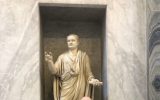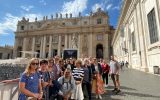
In an interview with David Walden, veteran tour guide of Jewish Rome and Jewish Insight at the Vatican, David shares some personal emotions regarding Jewish Rome.
The Great Synagogue of Rome is one of the most spectacular structures built at the turn of the last century in all of Italy and is perhaps the most impressive Italian synagogue built after the Italian emancipation in 1870. The Jewish Museum of Rome, which is located on the lower level of the Great synagogue complex, is an important point of reference for discovering the culture and traditions of the over two thousand year history of the Jews of Rome, the longest uninterrupted Jewish community in the world outside of Eretz Yisrael, the land of Israel.
Jews from all over including Levantine Jews as well as Jews from Arabia, Greece, Sicily, Spain, and North Africa, had often passed through Rome since ancient times, many of them choosing to settle there within and around it’s provinces.
Indeed, by the late 1400’s, there were many pious little Jewish communities just in the region of Lazio (Latium) alone.
By the mid 1500’s, the Roman Catholic anti-reformation decided to “upgrade” the degree of Jewish distinction, which had clearly and solely been of religious and ideological nature – into an actual physical separation by forcing into confines of a Serraglio or “holding pen” all those who dared to cling to the Torah and its precepts, grasping unto the fringes of the many diverse customs and traditions from whichever lands their ancestors’ paths had brought them.
While forever segregated yet more united than ever in life’s toil and mission, the Jews of Rome found themselves sharing a common fate among the centuries of persecution along with a persistent flicker of continuous belief in the arrival of Moshiach, expressed in the Talmud to be present at the “Gates of Rome” (Babylonian Talmud, Sanhedrin 98a). This would ultimately mark the true essence of Hashem’s promise to allow us once again to riunite in Jerusalem and perform the rituals of the Bet Hamikdash – the third and final Holy Temple.
Barely two square blocks along the banks of Rome’s Tiber River in the most squalid and malaria-infested slum of the city, where the sun seemingly had never shined, the men and boys crowding around the braziers of the smoke filled Cinque Scole, hanging onto the melodic notes of the chazanim and encouraging smiles of the Rabbis – the pious women and blushing modest girls brushing their hands from their eyes to their lips at the sight of the Torah scroll from behind the screen of the women’s gallery.
And yet, if even just for a moment, it is as if the sun shines through the darkest clouds of exile, allowing every shame and sorrow to be momentarily forgotten…. Barúch shenatán Toráh leamó Yisraél B’kdusható.
With a ceaseless yearning for the rebuilding of the Bet Hamikdash and the seemingly endless voyage of a people who through relentless struggle were eternally bound to one another by the Torah and its’ precepts, the Jews of Rome left behind a most precious legacy of literally hundreds of artifacts and documents, many of which can be seen in Rome’s Jewish Museum.
Nowhere else in the world can one find such incredibly rich collections of the world’s most beautiful and tapestries, Torah covers and their matching belts – so gracefully embroidered with quotes from scripture telling an almost unheard story of over 3 centuries.
The rarest and most exquisite Gold and Silver Torah crowns and Rimonim, each so expertly preserved and perfectly hand-crafted – flowing with symbolism and meaningful representation of the past and present, thus linking the vessels of the Temple of Jerusalem to the beautifully adorned Sifrei Torah we cherish so dearly in our synagogues until today.
From personal items such prayer books, prayer shawls and Teffilín (phylacteries) to Sefirat Ha’omer counters, decorated kettubot (marriage documents), silver Kiddush cups, and Etrog holders. All this and so much more affirms the love and commitment to daily Jewish life of a very singular Jewish community which has so much to tell and share.
David Walden’s three-hour excursion of the Jewish Museum, the two synagogues and the Jewish Quarter, narrates the fascinating history of the Jews of Rome who can trace their history back to the era of the Roman Republic of the second century BCE. He also offers Vatican tours from the Jewish perspective , the Ancient city and General Rome walking tours.
For more information visit:













Love the articles that Brenda writes. She is very knowledgeable and personable. We established a great rapport the moment we met in the lobby of The Excelsior in Rome for my tour of Jewish Rome